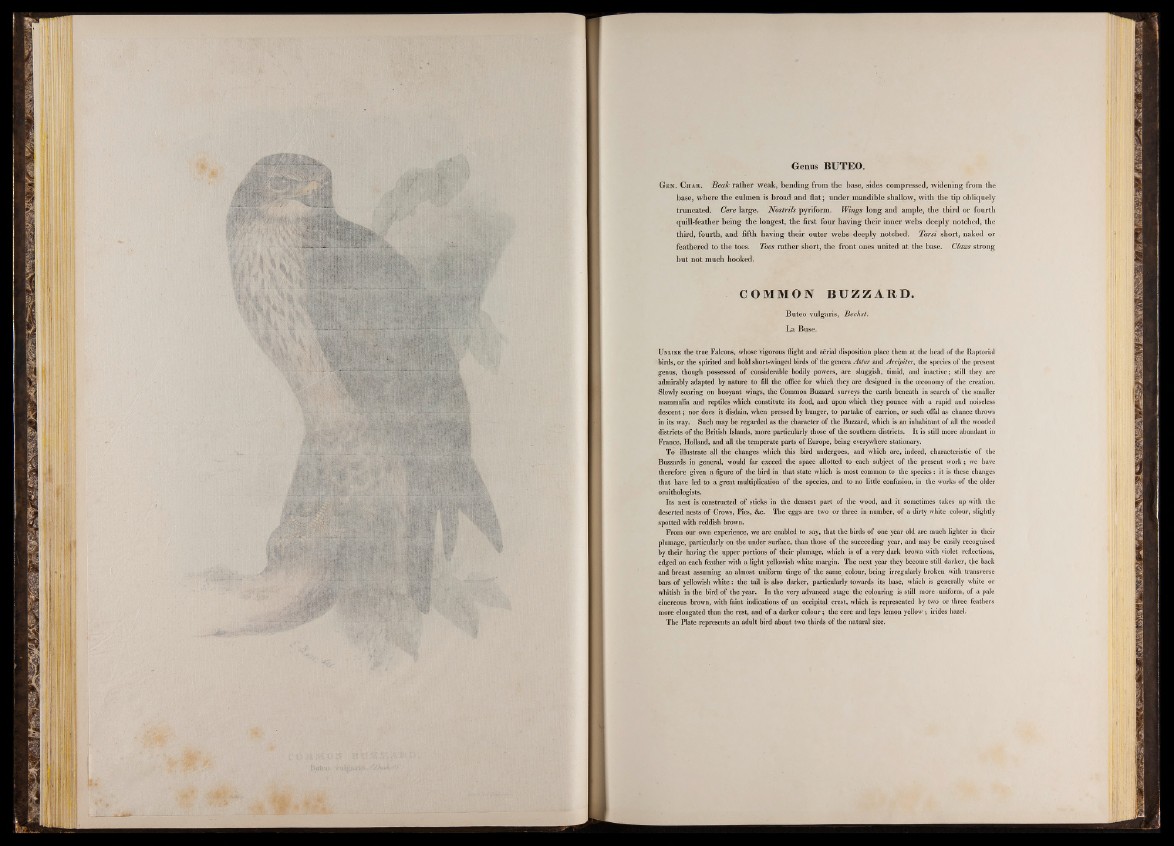
4 i ! v |
■ I
Hi
Genus BUTEO.
Gen. Char. Beak rather weak, bending from the base, sides compressed, widening from the
base, where the culmen is broad and flat; under mandible shallow, with the tip obliquely
truncated. Cere large. Nostrils pyriform. Wings long and ample, the third or fourth
quill-feather being the longest, the first four having their inner webs deeply notched, the
third, fourth, and fifth having their outer webs deeply notched. Tarsi short, naked or
feathered to the toes. Toes rather short, the front ones united at the base. Claws strong
but not much hooked.
COMMON BUZ ZA RD.
Buteo vulgaris, Bechst.
La Buse.
U nlike the true Falcons, whose vigorous flight and aerial disposition place them at the head of the Raptorial
birds, or the spirited and bold short-winged birds of the genera Astur and Accipiter, the species of the present
genus, though possessed of considerable bodily powers, are sluggish, timid, and inactive; still they are
admirably adapted by nature to fill the office for which they are designed in the oeconomy of the creation.
Slowly soaring on buoyant wings, the Common Buzzard surveys the earth beneath in search of the smaller
mammalia and reptiles which constitute its food, and upon which they pounce with a rapid and noiseless
descent; nor does it disdain, when pressed by hunger, to partake of carrion, or such offal as chance throws
in its way. Such may be regarded as the character of the Buzzard, which is an inhabitant of all the wooded
districts of the British Islands, more particularly those of the southern districts. It is still more abundant in
France, Holland, and all the temperate parts of Europe, being everywhere stationary.
To illustrate all the changes which this bird undergoes, and which are,- indeed, characteristic of the
Buzzards in general, would far exceed the space allotted to each subject of the present work; we have
therefore given a figure of the bird in that state which is most common to the species: it is these changes
that have led to a great multiplication of the species, and to no little confusion, in the works of the older
ornithologists.
Its nest is constructed of sticks in the densest part of the wood, and it sometimes takes up with the
deserted nests of Crows, Pies, &c. The eggs are two or three in number, of a dirty white colour, slightly
spotted with reddish brown.
From our own experience, we are enabled to say, that the birds of one year old are much lighter in their
plumage, particularly on the under surface, than those of the succeeding year, and may be easily recognised
by their having the upper portions of their plumage, which is of a very dark brown with violet reflections,
edged on each feather with a light yellowish white margin. The next year they become still darker, tjie back
and breast assuming an almost uniform tinge of the same colour, being irregularly broken with transverse
bars of yellowish white: the tail is also darker, particularly towards its base, which is generally white or
whitish in the bird of the year. In the very advanced stage the colouring is still more .uniform, of a pale
cinereous brown, with faint indications of an occipital crest, which is represented by two or three feathers
more elongated than the rest, and of a darker colour; the cere and legs lemon yellow; irides hazel.
The Plate represents an adult bird about two thirds of the natural size.